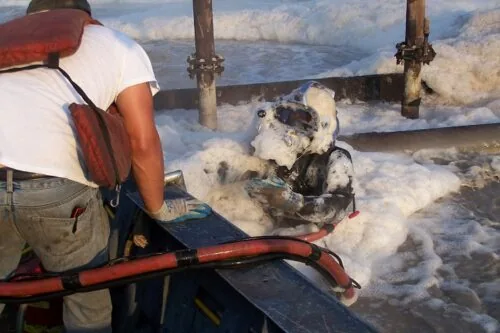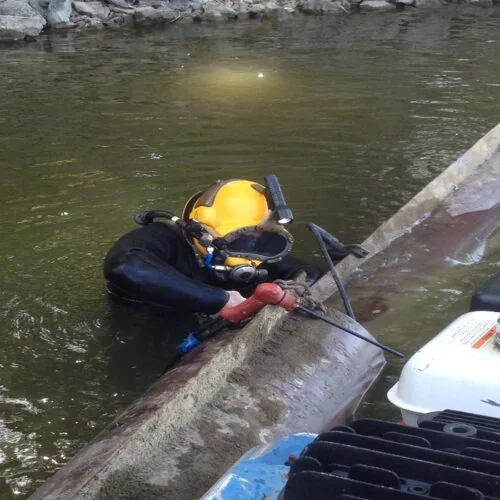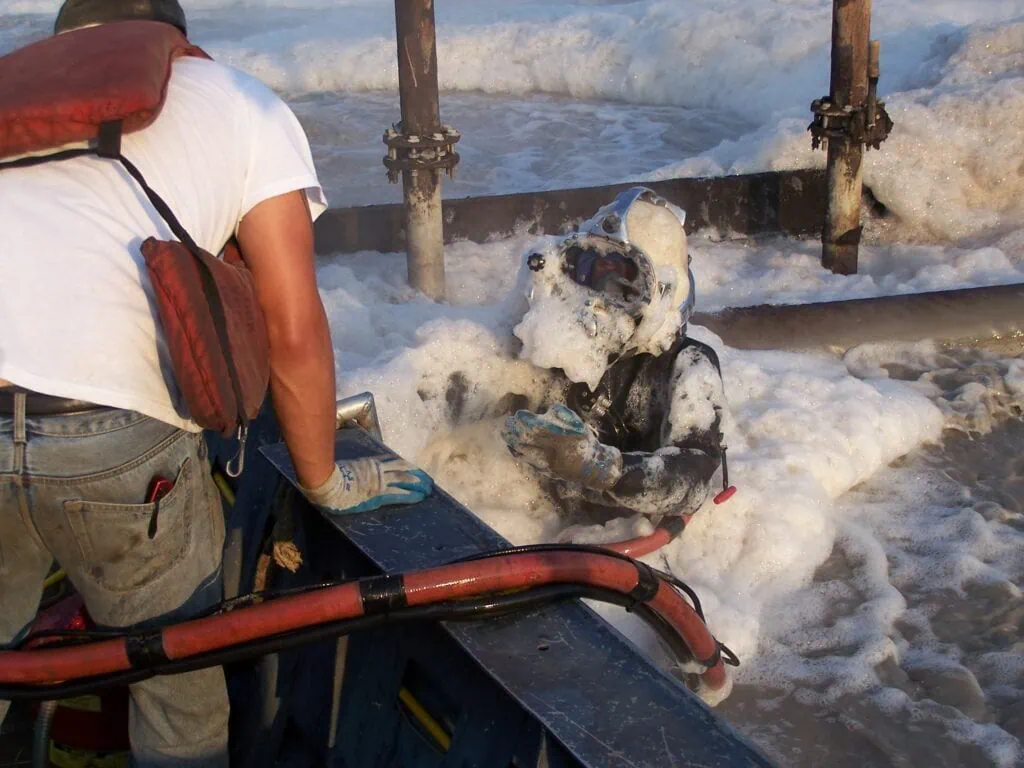Trends in technical diving for specific applications, multi-disciplinary training, safety, and future outlooks
ROCKPORT, Ind. – (May, 2023) – Bram Williams, President of Rockport-based Bulldog Diving, Inc., recently sat down to discuss trends in commercial diving, an industry little known beyond a few niche fields, where such services are frequently used. Commercial diving is a professional application in which rigorously trained divers engage in underwater work for construction, engineering, industrial cleaning, maintenance, item retrieval and other commercial purposes, similar to such work done out of the water. Unlike recreational applications, the diving itself is usually secondary to the work being performed.
 It is, by nature, a hazardous occupation, presenting many dangers that can far exceed those involved in sport diving. Typical recreational diving risks—such as decompression sickness (“the bends”) and pressure-related injuries to the ears and lungs—are still present, but commercial divers routinely face additional hazards. Conditions such as zero visibility, contaminated water, the presence of toxic gases and pressure differentials may all be present and require mindfulness. At the same time, the commercial diver must also be cognizant of changing tide and lighting conditions, pay attention to communications and instructions, and safely and effectively operate industrial tools and equipment.
It is, by nature, a hazardous occupation, presenting many dangers that can far exceed those involved in sport diving. Typical recreational diving risks—such as decompression sickness (“the bends”) and pressure-related injuries to the ears and lungs—are still present, but commercial divers routinely face additional hazards. Conditions such as zero visibility, contaminated water, the presence of toxic gases and pressure differentials may all be present and require mindfulness. At the same time, the commercial diver must also be cognizant of changing tide and lighting conditions, pay attention to communications and instructions, and safely and effectively operate industrial tools and equipment.
Service differentials
Some commercial divers specialize in “offshore”—deep water and coastal ocean— locations, while others tend to service “inshore” spots, such as manufacturing and utility plants, some along lakes and waterways, or underground environments such as water or wastewater collection, distribution and treatment systems and plants. Many commercial dive operations also provide topside—or above-surface—services similar to those they perform in underwater environments, because the skill sets and work gear are mostly the same. Not all are equipped for these related tasks, however.
“Offshore diving is much more technical than inshore diving, primarily due to diving depths,” explains Williams. “The technology gap between dive operations is also apparent in the ownership and use of ROVs (Remote-Operated Vehicles). Again, this is primarily due to water depths; ROVs have no “dive time” limits, and have been adapted to accomplish certain tasks that divers used to do. It is an enormous task and cost for a dive team to operate deep, especially on mixed gas, or in saturation diving. These are real differences in the two markets.
Both service applications currently use the same headgear, diving helmets, in underwater situations.
Same, but different

This is an issue, because at anywhere from 27-30 pounds, traditional diving helmets are heavy and cumbersome to use out of the water. When Bulldog Diving began getting requests to perform work in environments that, while wet, weren’t necessarily underwater, they took a look at this reality.
In enclosed or confined spaces such as sewer tunnels and sanitary treatment basins, where they weren’t underwater but still required the full encapsulation of a non-permeable diving suit paired with a dive helmet due to hazardous gas presence, the helmet felt even heavier, because there was no surrounding water to provide extra buoyancy to support it.
Williams, with a creative bent and analytical mind, believed there was a better way. Working with a colleague who had the engineering chops, he developed a helmet that—because it didn’t need to withstand the crush pressure of a submersible model—was able to provide hazardous gas protection using positive air pressure, at a far lighter weight. They came up with what they call the MK3 Topside Helmet. Even with the capability for two-way communications inside, it weighs in at a cool five pounds, a full 80-83% lighter than traditional models.
“I think it’s going to be extremely valuable to the inshore market,” Williams projects. “It would have no use offshore, because offshore operations are always underwater. Divers are already trained in wearing, breathing out of, and communicating inside a helmet, while wearing an air supply. If you mount it to an encapsulating HazCon suit, it works the same. In the inshore industrial market, there are so many situations that aren’t full underwater diving. They’re just wet or have a foot of water or so, and don’t have the ability to support a 30-pound helmet.”
Focus shifts to Environment and Safety
Divers with specific work skills—not necessarily underwater, but those who can work in full encapsulation—are being sought for unusual situations in which they may not have been considered before. The primary reason, says Williams, is that, “when I started in the early 80s, the focus on the environment and safety was nothing, compared to what it is today. It was just a different world back then. Today, environmentally and safety-wise, industrial plants will go to great lengths to accomplish a task that would be considered hazardous. They want as many buffers as they can have in the safety and environmental compliance end of getting the job done.”
In projects that involve what are considered “non-life-supporting conditions”—usually some type of toxic gas or chemical hazard—plant managers, engineers and safety personnel will convene to discuss how to achieve an inspection or item retrieval or repair. “Somebody will ask, ‘What if this, or what if that? We can do it this way, but what if?’” explains Williams. “And that often leads to us, because they can’t satisfy that what if. They have to go to the next layer of safety, which is full encapsulation, or just a splash protection and fresh air encapsulation system.” A helmet like the MK3, which has the ability to accommodate two-way communication and several other functional attachments, allows such a solution.
Safety is Paramount
Somewhere around the 16th century, people began diving not just to explore the ocean, but for commercial purposes such as the salvage of wrecks, retrieving lost cargo, and repair and maintenance of underwater structures. In the five intervening centuries, the main branches of commercial diving evolved into offshore, inshore, scientific and nuclear work. Offshore and inshore diving, the most popular, focus on underwater welding and maintenance. For so many reasons, both obvious and hidden, safety in commercial diving now holds a top place in consideration when planning a project.
Commercial divers are trained to weld and burn underwater, which require the use of potentially harmful tools, substances and techniques. Other hazards include elevated water temperatures, water with wildly divergent pH levels, or that’s murky or completely lacking visibility.
Water temperatures above 99 degrees can cause discomfort and premature exhaustion, requiring frequent crew changes. If the water’s pH is too high or too low, both conditions can burn human skin. “If you don’t understand that the surrounding water’s pH or temperature may be elevated, a diver can get in trouble really quick if he’s not careful about working in situations like that.”
And in the industrial sector, divers are working in water that may contain byproducts and other substances that may be toxic. Then there’s the trepidation of being unable to see one’s hand directly in front of one’s face, and the disorientation that causes.
“In the high 90% of the waters we get in, there’s no visibility at all,” says Williams. “You can’t see anything. It’s not for some divers. They don’t want to deal with it.”
Bulldog addresses these issues by thoroughly cross-training its 15-20 regular divers to operate safely and with efficiency in such conditions. All are multi-disciplinary, and share in a rotation of job responsibilities, keeping each crew member fresh and in the know.
“They understand what they’re getting into, and they’re very experienced at it,” Williams reflects. “A lot of our guys have been with us for a really long time, so they can even answer questions from clients on the job site. They just have a solid understanding of what it takes to operate safely in a situation like that.”
Future Thoughts
Williams sees two related issues driving the future of inshore commercial diving: permitting for repair and maintenance of underground infrastructure, and the need for highly trained, multi-disciplinary divers to work in confined spaces. For example, if some municipalities require work to be done in a sewer main, “in a really nice neighborhood or in the middle of a city where there are buildings over top of them, they just can’t get permitting for trench excavation or water bypass.” So these cities call commercial divers, who may have to work in a trenchless mode, in live sewer situations.
Aside from the permitting issue, there are other clients who may need such divers in other confined spaces. Nearly all industrial plants use some type of hazardous chemicals, which create situations where management doesn’t feel safe putting one of their workers in a confined space.
“Whether it’s going in a tunnel that they fear has noxious gases in it, to do an inspection or look at something, or to accomplish a task; cleaning a hazardous tank, or any one of so many situations a plant might experience,” Williams says, “that’s the big thing, confined space. It’s really sensitive with just about all industrial users now, so that’s the big key. Whether a tunnel or just a room, it could be any confined space” that represents major future opportunities for experienced commercial diving operations, with the right gear to get the job done.

